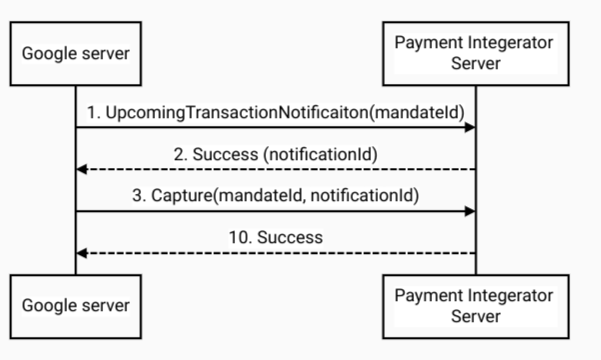AI-generated Key Takeaways
-
The Upcoming Transaction Notification flow informs users via the Payment Integrator about upcoming transactions on their accounts.
-
This notification's proof can be utilized in other processes like capturing funds.
-
Google Servers initiate the flow by triggering a system charge, sending a notification request to the Payment Integrator Server, and then a capture request using the mandate and notification IDs.
-
The Payment Integrator Server responds with success messages, completing the charge process.
Overview
The purpose of the Upcoming Transaction Notification flow is to notify the user through the Payment Integrator (integrator) about an upcoming transaction on user's account.
Upcoming Transaction Notification's proof may be used as an input to other methods, like capture.
How the flow works
The diagram below shows a upcoming transaction notification and capture Flow.
Upcoming Transaction Notification

The objects in the diagram include the following:
- Google Server: The backend server at Google that sends the capture command to the Payment Integrator Server.
- Payment Integrator Server: The backend server of the integrator that accepts the request for a funds capture.
In this upcoming transaction notification flow, the user is not in session. They flow begins by Google Servers triggering a system-initiated charge.
- Google’s Server sends the
UpcomingTransactionNotificationrequest (mandateId) to the Payment Integrator Server. - The Payment Integrator Server sends back a Success response to the Google Server, with the
notificationId. - Google’s Server sends the
Capturerequest (mandateId,notificationId) to the Payment Integrator Server. - The Payment Integrator Server sends back a Success response to the Google Server and the charge is complete.